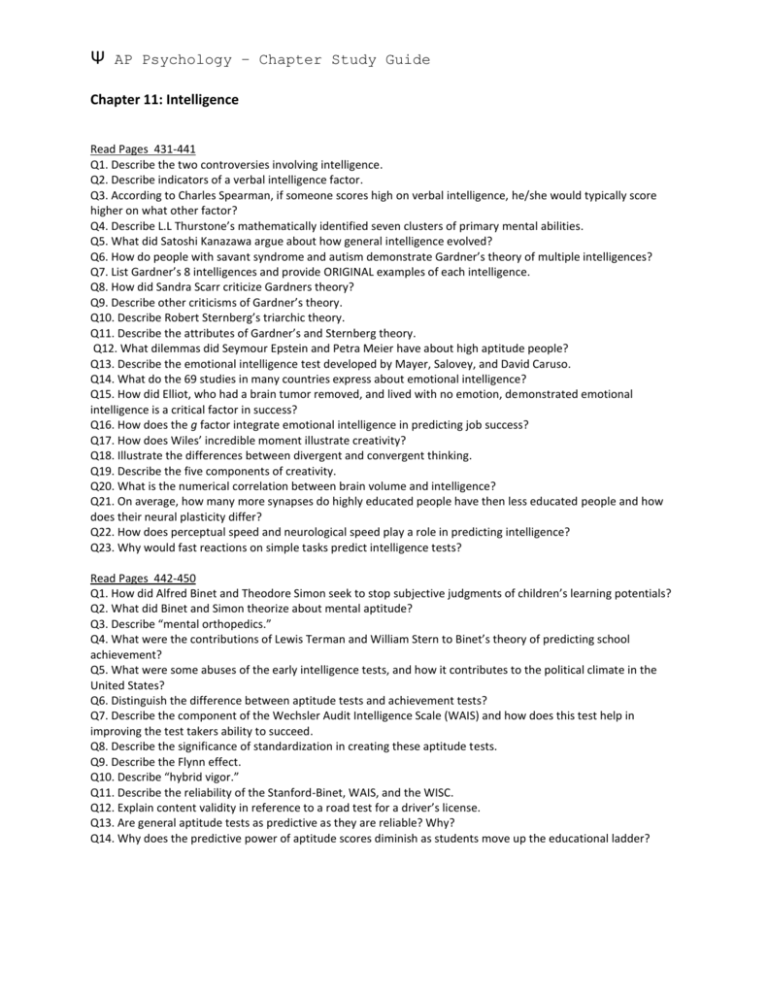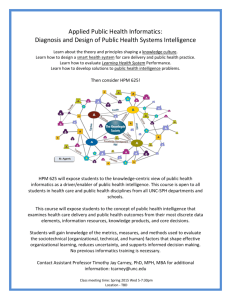Ψ AP Psychology – Chapter Study Guide Chapter 11: Intelligence
advertisement

Ψ AP Psychology – Chapter Study Guide Chapter 11: Intelligence Read Pages 431-441 Q1. Describe the two controversies involving intelligence. Q2. Describe indicators of a verbal intelligence factor. Q3. According to Charles Spearman, if someone scores high on verbal intelligence, he/she would typically score higher on what other factor? Q4. Describe L.L Thurstone’s mathematically identified seven clusters of primary mental abilities. Q5. What did Satoshi Kanazawa argue about how general intelligence evolved? Q6. How do people with savant syndrome and autism demonstrate Gardner’s theory of multiple intelligences? Q7. List Gardner’s 8 intelligences and provide ORIGINAL examples of each intelligence. Q8. How did Sandra Scarr criticize Gardners theory? Q9. Describe other criticisms of Gardner’s theory. Q10. Describe Robert Sternberg’s triarchic theory. Q11. Describe the attributes of Gardner’s and Sternberg theory. Q12. What dilemmas did Seymour Epstein and Petra Meier have about high aptitude people? Q13. Describe the emotional intelligence test developed by Mayer, Salovey, and David Caruso. Q14. What do the 69 studies in many countries express about emotional intelligence? Q15. How did Elliot, who had a brain tumor removed, and lived with no emotion, demonstrated emotional intelligence is a critical factor in success? Q16. How does the g factor integrate emotional intelligence in predicting job success? Q17. How does Wiles’ incredible moment illustrate creativity? Q18. Illustrate the differences between divergent and convergent thinking. Q19. Describe the five components of creativity. Q20. What is the numerical correlation between brain volume and intelligence? Q21. On average, how many more synapses do highly educated people have then less educated people and how does their neural plasticity differ? Q22. How does perceptual speed and neurological speed play a role in predicting intelligence? Q23. Why would fast reactions on simple tasks predict intelligence tests? Read Pages 442-450 Q1. How did Alfred Binet and Theodore Simon seek to stop subjective judgments of children’s learning potentials? Q2. What did Binet and Simon theorize about mental aptitude? Q3. Describe “mental orthopedics.” Q4. What were the contributions of Lewis Terman and William Stern to Binet’s theory of predicting school achievement? Q5. What were some abuses of the early intelligence tests, and how it contributes to the political climate in the United States? Q6. Distinguish the difference between aptitude tests and achievement tests? Q7. Describe the component of the Wechsler Audit Intelligence Scale (WAIS) and how does this test help in improving the test takers ability to succeed. Q8. Describe the significance of standardization in creating these aptitude tests. Q9. Describe the Flynn effect. Q10. Describe “hybrid vigor.” Q11. Describe the reliability of the Stanford-Binet, WAIS, and the WISC. Q12. Explain content validity in reference to a road test for a driver’s license. Q13. Are general aptitude tests as predictive as they are reliable? Why? Q14. Why does the predictive power of aptitude scores diminish as students move up the educational ladder? Ψ AP Psychology – Chapter Study Guide Read Pages 450- 454 Q1. What did Nancy Bayley speculate about infant behavior? Q2. At what age do intelligence tests predict behavior school achievement? Why? Q3. Describe the correlation between GRE and SAT verbal tests? Q4. Provide an example of how intelligence endures and stabilizes? Q5. Describe the four degrees of mental retardation and how it adapts to the demands of life. Q6. Describe the last half of the century concerning the environment for children with mild mental retardation compared to the first half of the century. Q7. What conclusions were drawn concerning Lewis Terman’s project involving gifted California school children with IQ scores over 135? Q8. Describe some of the assumptions of currently popular gifted children's programs. Q9. Describe the self-fulfilling prophecy when students are labeled "ungifted." Q10. What do critics and proponents of gifted education agree on? Read Pages 454-459 Q1. Illustrate the three sets of findings concerning genetic influences on intelligence. Q2. Describe the findings of adopted children and their adopted families as parental influences wane. Q3. Describe habitability and its impact on the environment. Q4. How do genes and environment correlate? Q5. What would happen in term so school success if you had a slightly genetically disposed intelligence edge? Q6. Describe Hunt’s program of untutored human enrichment. Q7. How does Hunt’s findings testify to the importance of environment? Q8. Describe the study of 1450 Virginia schools concerning schools with lots of poverty-level children. Q9. Describe the Head Start program and if there are nay long term benefits. Q10. How does high intelligence and schooling contribute to each other? Q11. What are the two disturbing but agreed upon facts concerning ethnic similarities and differences? Q12. Describe some specific examples of intelligence test differences in certain groups. Q13. How is heritability attributed to racial differences in intelligence scores? Q14. Is the racial gap similarly environmental? Provide an example of individual differences vs. group differences. Q15. How would social scientists define race? Q16. Why is Asian students outperforming North America students on math achievement and aptitude tests a recent phenomenon? Q17. Describe the striking results of a national study that looked back over the mental test performances of white and black young adults after graduation from college. Q18. Describe gender differences in spelling, verbal ability, nonverbal memory, sensation, underachievement, and math and spatial aptitudes. Q19. Describe the evolutionary perspective in gender differences. Q20. Is there a biological explanation to account for the gender differences? Q21. How do social expectations play a role in shaping boys’ and girls’ abilities and interests? Q22. Describe the emotion detecting ability of the women, and how it plays a role in our ancestral past? Q23. What do the defenders of aptitude testing note about racial group differences? Q24. Why do psychologists believe that the U.S major aptitude tests are not bias? Q25. Describe the predictive validity of the SAT? Q26. How does the stereotype threat describe the aptitude of women and blacks under non-threatening and threatening test conditions? Q27. Why will some students “disidentify” with school achievement? Q28. Are aptitude tests discriminatory? Why?






